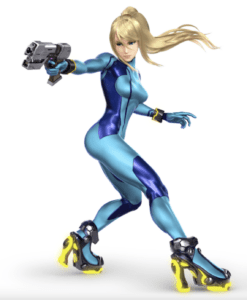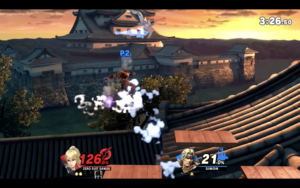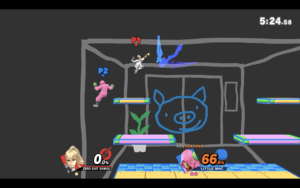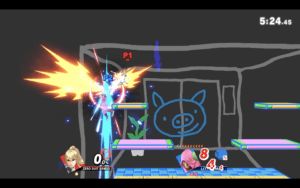This week I played the Nintendo Switch game Super Smash Bros. Ultimate (SSBU) and fought as the playable character Zero Suit Samus (ZSS). SSBU is known as a family-friendly fighting game, rated for everyone 10 and up, that mainly features characters from Nintendo’s most prominent franchises. For this reason, I would say that the target audience is anyone that is familiar with with Nintendo characters, which could be anyone of any age. However, this could still lean towards boys and men since young girls are not encouraged or pushed to play video games, as Shira Chess mentions in her book. The fighting nature of SSBU could also deter girls and women that may be intimated by or have internalized the fact that they should not find entertainment in violence, even if it is cartoonish. And considering all these factors, I would say the game’s main modes of fun are fantasy and challenge.
I had played SSBU before but have usually played as Link or Chrom. And if I’m being honest, I chose to play as ZSS just because her ponytail reminded me of Ariana Grande (my pop diva for real). This also prompted me to analyze the character’s design.

As shown above, ZSS is equipped with a laser gun that shoots out stun bullets and a laser whip. She has a tall figure that is further enhanced by her high-heel rocket boots. Still, her most noticeable features are her high ponytail and her light blue suit. From a feminist perspective, my only concern would be the necessity of her suit being skin tight. She does not have any womanly features that are over exaggerated (think Mortal Kombat woman characters), which is probably due to the fact that SSBU is a family game. However, I think it does not have to be as tight as it is.
On the other hand, one might think that the rocket boots could just be shoes instead of high heels. But considering the mechanics of the game, the extra height of the heels allows ZSS to have one of the longest strides in the game. This is especially useful when the player wants to quickly reach and punish their opponent. Furthermore, I found ZSS to be an extremely fun and enjoyable character. Her movement style allows her to get around the stage quickly and to weave in and out of interactions with her opponent. Her signature move, the flip-kick, adds so much to her movement and punishment game. Although it’s called flip-kick the player does not have to activate the kick and can just flip/jump to quickly get somewhere. The flip itself also gives her frames of invincibility (indicated the white flash), which is helpful to get out of danger.

But when the kick is used, it just makes the player feel like a badass. The kick has a spike effect that instantly plummets the opponent towards the bottom of the stage. This gives the opponent no chance to recover and instantly lose a stock/life. It’s also the most disrespectful and taunting way to make your opponent lose (good for me, bad for my friends eek).


Overall, I like how the game features woman fighters without over sexualizing them, unlike Mortal Kombat, Tekken, any anime fighting game, etc. Some of these characters are also known in the meta as objectively good fighters, such as ZSS, Palutena, and Lucina. Still, it’s hard to ignore the fact that the game’s roster is predominantly manish or male characters. To make maters worse, there are hardly any woman characters that are brown-skinned (only available as an alternate costume… but not the main default 🙁 ). Thus, this clearly indicates that Nintendo needs to start creating more mainstream games that feature woman characters of more complex stories and different backgrounds (race, class, sexuality, etc). This way, there would be a greater variety of characters in SSBU.
Since Nintendo games are played by many kids, my question is this: How can we teach children complex themes about identity in a way that they can grasp while having fun by playing games?



